Finance for Managers: Comprehensive Analysis of Financial Concepts
VerifiedAdded on 2020/01/28
|18
|5283
|116
Report
AI Summary
This report provides a comprehensive overview of finance for managers, covering essential concepts such as financial record-keeping, stakeholder analysis, and variance analysis. The introduction highlights the significance of financial resources in an organization and their role in decision-making. Task 1 delves into the importance of financial record-keeping, its requirements, and the common forms used, including income statements, balance sheets, and cash flow statements. It also discusses the role of stakeholders and their varying needs for financial information. Task 2 presents variance analysis and a reconciliation statement, offering insights into the business's financial performance. Finally, Task 3 explores budgeting processes and various pricing techniques. The report provides a detailed analysis of these core financial concepts, making it a valuable resource for students and professionals alike.

FINANCE FOR MANAGERS
Paraphrase This Document
Need a fresh take? Get an instant paraphrase of this document with our AI Paraphraser

TABLE OF CONTENTS
INTRODUCTION...........................................................................................................................1
TASK 1............................................................................................................................................1
1.1...........................................................................................................................................1
1.2...........................................................................................................................................2
1.3...........................................................................................................................................3
1.4...........................................................................................................................................4
1.5...........................................................................................................................................5
1.6...........................................................................................................................................5
TASK 2............................................................................................................................................6
2.1...........................................................................................................................................6
TASK 3............................................................................................................................................8
3.1...........................................................................................................................................8
3.2.........................................................................................................................................11
3.3.........................................................................................................................................13
3.4.........................................................................................................................................14
CONCLUSION..............................................................................................................................15
REFERENCES..............................................................................................................................16
INTRODUCTION...........................................................................................................................1
TASK 1............................................................................................................................................1
1.1...........................................................................................................................................1
1.2...........................................................................................................................................2
1.3...........................................................................................................................................3
1.4...........................................................................................................................................4
1.5...........................................................................................................................................5
1.6...........................................................................................................................................5
TASK 2............................................................................................................................................6
2.1...........................................................................................................................................6
TASK 3............................................................................................................................................8
3.1...........................................................................................................................................8
3.2.........................................................................................................................................11
3.3.........................................................................................................................................13
3.4.........................................................................................................................................14
CONCLUSION..............................................................................................................................15
REFERENCES..............................................................................................................................16

INTRODUCTION
The base of an organisation is in its financial resources that are utilised by the company, a
major focus of management. Financial management gives more importance to the financial
aspects involved in the business which helps administration to take decisions regarding cost
reduction by using finance in the form of business funding. It also stresses on costs determination
by using variance analysis in the business. Various project evaluation tools are also used in order
top assess the project viability in order to select or reject the certain proposals.
TASK 1
1.1
Financial record keeping plays a significant role in an enterprise as it covers the major
monetary business activities which helps the company to keep records for operational and legal
purposes (Denison, 2010). There are various requirements and purpose of the financial record
keeping which are given as below:
The records of different business transactions takes place in an entity is required for tax
preparation and filling as the basic requirement of the taxation authority is to submit all
the business records that reveals true income of the business entity. This is a legal
requirement, and limited companies can be fined for not complying.
The business records are helpful in negotiating with the banks for taking loans as their
main aim is to record each and every transaction that forms part of business activities.
The accrual concept of accounting also helps in recording every transactions of sale
without receiving payment in context for avoiding any forged vouchers and further future
consequences.
By keeping financial records in proper direction, the company able to assess its capability
in terms of generating sales and revenue at the end of an accounting period.
In addition to this, day-to-day costs, expenditures as well as the income can be easily
determined by the management when it keeps record of financial transactions.
For making comparison of current financial performance with the past, the financial
records are highly supportive. Along with this, through this particular procedure, the
company can compare with the competitor business entity as well.
1
The base of an organisation is in its financial resources that are utilised by the company, a
major focus of management. Financial management gives more importance to the financial
aspects involved in the business which helps administration to take decisions regarding cost
reduction by using finance in the form of business funding. It also stresses on costs determination
by using variance analysis in the business. Various project evaluation tools are also used in order
top assess the project viability in order to select or reject the certain proposals.
TASK 1
1.1
Financial record keeping plays a significant role in an enterprise as it covers the major
monetary business activities which helps the company to keep records for operational and legal
purposes (Denison, 2010). There are various requirements and purpose of the financial record
keeping which are given as below:
The records of different business transactions takes place in an entity is required for tax
preparation and filling as the basic requirement of the taxation authority is to submit all
the business records that reveals true income of the business entity. This is a legal
requirement, and limited companies can be fined for not complying.
The business records are helpful in negotiating with the banks for taking loans as their
main aim is to record each and every transaction that forms part of business activities.
The accrual concept of accounting also helps in recording every transactions of sale
without receiving payment in context for avoiding any forged vouchers and further future
consequences.
By keeping financial records in proper direction, the company able to assess its capability
in terms of generating sales and revenue at the end of an accounting period.
In addition to this, day-to-day costs, expenditures as well as the income can be easily
determined by the management when it keeps record of financial transactions.
For making comparison of current financial performance with the past, the financial
records are highly supportive. Along with this, through this particular procedure, the
company can compare with the competitor business entity as well.
1
⊘ This is a preview!⊘
Do you want full access?
Subscribe today to unlock all pages.

Trusted by 1+ million students worldwide
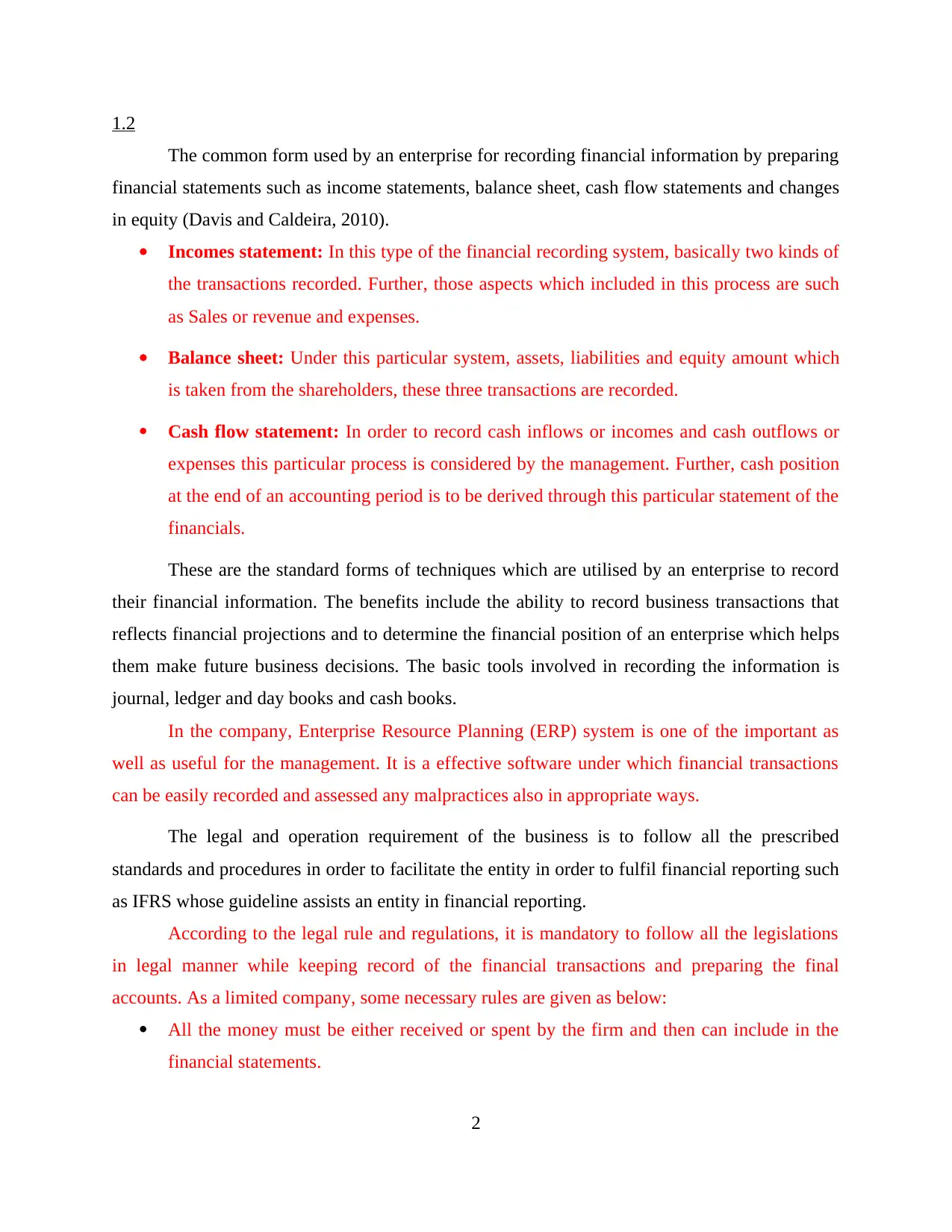
1.2
The common form used by an enterprise for recording financial information by preparing
financial statements such as income statements, balance sheet, cash flow statements and changes
in equity (Davis and Caldeira, 2010).
Incomes statement: In this type of the financial recording system, basically two kinds of
the transactions recorded. Further, those aspects which included in this process are such
as Sales or revenue and expenses.
Balance sheet: Under this particular system, assets, liabilities and equity amount which
is taken from the shareholders, these three transactions are recorded.
Cash flow statement: In order to record cash inflows or incomes and cash outflows or
expenses this particular process is considered by the management. Further, cash position
at the end of an accounting period is to be derived through this particular statement of the
financials.
These are the standard forms of techniques which are utilised by an enterprise to record
their financial information. The benefits include the ability to record business transactions that
reflects financial projections and to determine the financial position of an enterprise which helps
them make future business decisions. The basic tools involved in recording the information is
journal, ledger and day books and cash books.
In the company, Enterprise Resource Planning (ERP) system is one of the important as
well as useful for the management. It is a effective software under which financial transactions
can be easily recorded and assessed any malpractices also in appropriate ways.
The legal and operation requirement of the business is to follow all the prescribed
standards and procedures in order to facilitate the entity in order to fulfil financial reporting such
as IFRS whose guideline assists an entity in financial reporting.
According to the legal rule and regulations, it is mandatory to follow all the legislations
in legal manner while keeping record of the financial transactions and preparing the final
accounts. As a limited company, some necessary rules are given as below:
All the money must be either received or spent by the firm and then can include in the
financial statements.
2
The common form used by an enterprise for recording financial information by preparing
financial statements such as income statements, balance sheet, cash flow statements and changes
in equity (Davis and Caldeira, 2010).
Incomes statement: In this type of the financial recording system, basically two kinds of
the transactions recorded. Further, those aspects which included in this process are such
as Sales or revenue and expenses.
Balance sheet: Under this particular system, assets, liabilities and equity amount which
is taken from the shareholders, these three transactions are recorded.
Cash flow statement: In order to record cash inflows or incomes and cash outflows or
expenses this particular process is considered by the management. Further, cash position
at the end of an accounting period is to be derived through this particular statement of the
financials.
These are the standard forms of techniques which are utilised by an enterprise to record
their financial information. The benefits include the ability to record business transactions that
reflects financial projections and to determine the financial position of an enterprise which helps
them make future business decisions. The basic tools involved in recording the information is
journal, ledger and day books and cash books.
In the company, Enterprise Resource Planning (ERP) system is one of the important as
well as useful for the management. It is a effective software under which financial transactions
can be easily recorded and assessed any malpractices also in appropriate ways.
The legal and operation requirement of the business is to follow all the prescribed
standards and procedures in order to facilitate the entity in order to fulfil financial reporting such
as IFRS whose guideline assists an entity in financial reporting.
According to the legal rule and regulations, it is mandatory to follow all the legislations
in legal manner while keeping record of the financial transactions and preparing the final
accounts. As a limited company, some necessary rules are given as below:
All the money must be either received or spent by the firm and then can include in the
financial statements.
2
Paraphrase This Document
Need a fresh take? Get an instant paraphrase of this document with our AI Paraphraser
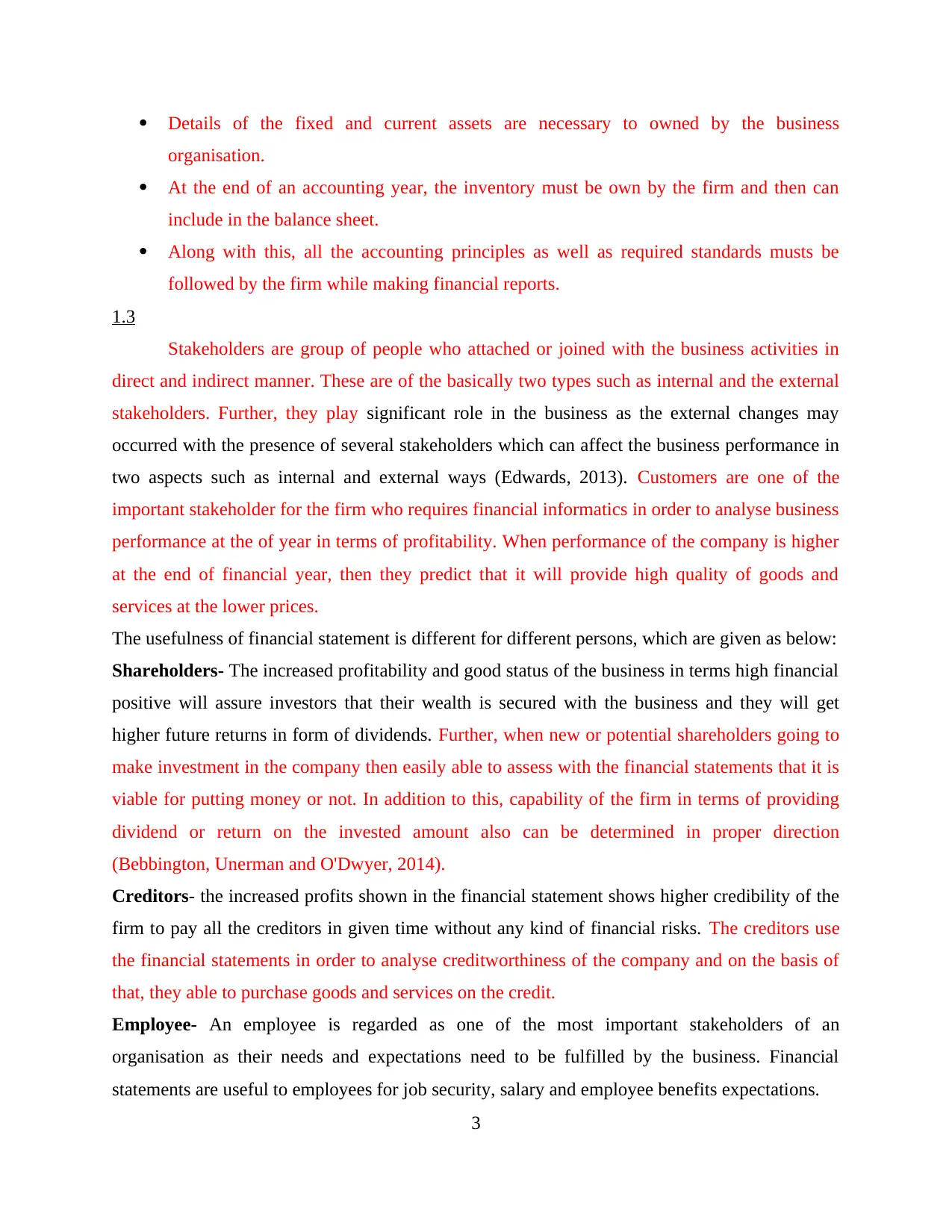
Details of the fixed and current assets are necessary to owned by the business
organisation.
At the end of an accounting year, the inventory must be own by the firm and then can
include in the balance sheet.
Along with this, all the accounting principles as well as required standards musts be
followed by the firm while making financial reports.
1.3
Stakeholders are group of people who attached or joined with the business activities in
direct and indirect manner. These are of the basically two types such as internal and the external
stakeholders. Further, they play significant role in the business as the external changes may
occurred with the presence of several stakeholders which can affect the business performance in
two aspects such as internal and external ways (Edwards, 2013). Customers are one of the
important stakeholder for the firm who requires financial informatics in order to analyse business
performance at the of year in terms of profitability. When performance of the company is higher
at the end of financial year, then they predict that it will provide high quality of goods and
services at the lower prices.
The usefulness of financial statement is different for different persons, which are given as below:
Shareholders- The increased profitability and good status of the business in terms high financial
positive will assure investors that their wealth is secured with the business and they will get
higher future returns in form of dividends. Further, when new or potential shareholders going to
make investment in the company then easily able to assess with the financial statements that it is
viable for putting money or not. In addition to this, capability of the firm in terms of providing
dividend or return on the invested amount also can be determined in proper direction
(Bebbington, Unerman and O'Dwyer, 2014).
Creditors- the increased profits shown in the financial statement shows higher credibility of the
firm to pay all the creditors in given time without any kind of financial risks. The creditors use
the financial statements in order to analyse creditworthiness of the company and on the basis of
that, they able to purchase goods and services on the credit.
Employee- An employee is regarded as one of the most important stakeholders of an
organisation as their needs and expectations need to be fulfilled by the business. Financial
statements are useful to employees for job security, salary and employee benefits expectations.
3
organisation.
At the end of an accounting year, the inventory must be own by the firm and then can
include in the balance sheet.
Along with this, all the accounting principles as well as required standards musts be
followed by the firm while making financial reports.
1.3
Stakeholders are group of people who attached or joined with the business activities in
direct and indirect manner. These are of the basically two types such as internal and the external
stakeholders. Further, they play significant role in the business as the external changes may
occurred with the presence of several stakeholders which can affect the business performance in
two aspects such as internal and external ways (Edwards, 2013). Customers are one of the
important stakeholder for the firm who requires financial informatics in order to analyse business
performance at the of year in terms of profitability. When performance of the company is higher
at the end of financial year, then they predict that it will provide high quality of goods and
services at the lower prices.
The usefulness of financial statement is different for different persons, which are given as below:
Shareholders- The increased profitability and good status of the business in terms high financial
positive will assure investors that their wealth is secured with the business and they will get
higher future returns in form of dividends. Further, when new or potential shareholders going to
make investment in the company then easily able to assess with the financial statements that it is
viable for putting money or not. In addition to this, capability of the firm in terms of providing
dividend or return on the invested amount also can be determined in proper direction
(Bebbington, Unerman and O'Dwyer, 2014).
Creditors- the increased profits shown in the financial statement shows higher credibility of the
firm to pay all the creditors in given time without any kind of financial risks. The creditors use
the financial statements in order to analyse creditworthiness of the company and on the basis of
that, they able to purchase goods and services on the credit.
Employee- An employee is regarded as one of the most important stakeholders of an
organisation as their needs and expectations need to be fulfilled by the business. Financial
statements are useful to employees for job security, salary and employee benefits expectations.
3
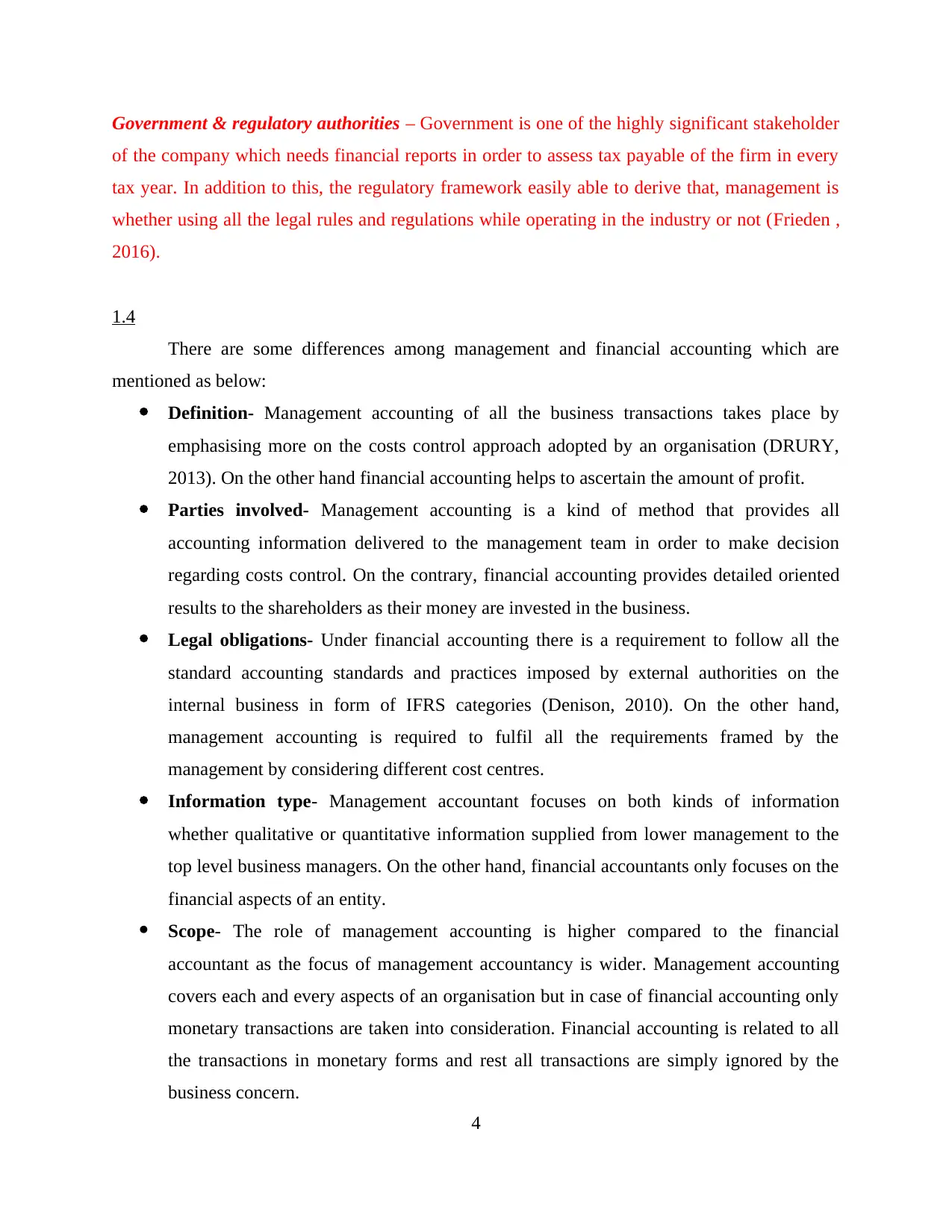
Government & regulatory authorities – Government is one of the highly significant stakeholder
of the company which needs financial reports in order to assess tax payable of the firm in every
tax year. In addition to this, the regulatory framework easily able to derive that, management is
whether using all the legal rules and regulations while operating in the industry or not (Frieden ,
2016).
1.4
There are some differences among management and financial accounting which are
mentioned as below:
Definition- Management accounting of all the business transactions takes place by
emphasising more on the costs control approach adopted by an organisation (DRURY,
2013). On the other hand financial accounting helps to ascertain the amount of profit.
Parties involved- Management accounting is a kind of method that provides all
accounting information delivered to the management team in order to make decision
regarding costs control. On the contrary, financial accounting provides detailed oriented
results to the shareholders as their money are invested in the business.
Legal obligations- Under financial accounting there is a requirement to follow all the
standard accounting standards and practices imposed by external authorities on the
internal business in form of IFRS categories (Denison, 2010). On the other hand,
management accounting is required to fulfil all the requirements framed by the
management by considering different cost centres.
Information type- Management accountant focuses on both kinds of information
whether qualitative or quantitative information supplied from lower management to the
top level business managers. On the other hand, financial accountants only focuses on the
financial aspects of an entity.
Scope- The role of management accounting is higher compared to the financial
accountant as the focus of management accountancy is wider. Management accounting
covers each and every aspects of an organisation but in case of financial accounting only
monetary transactions are taken into consideration. Financial accounting is related to all
the transactions in monetary forms and rest all transactions are simply ignored by the
business concern.
4
of the company which needs financial reports in order to assess tax payable of the firm in every
tax year. In addition to this, the regulatory framework easily able to derive that, management is
whether using all the legal rules and regulations while operating in the industry or not (Frieden ,
2016).
1.4
There are some differences among management and financial accounting which are
mentioned as below:
Definition- Management accounting of all the business transactions takes place by
emphasising more on the costs control approach adopted by an organisation (DRURY,
2013). On the other hand financial accounting helps to ascertain the amount of profit.
Parties involved- Management accounting is a kind of method that provides all
accounting information delivered to the management team in order to make decision
regarding costs control. On the contrary, financial accounting provides detailed oriented
results to the shareholders as their money are invested in the business.
Legal obligations- Under financial accounting there is a requirement to follow all the
standard accounting standards and practices imposed by external authorities on the
internal business in form of IFRS categories (Denison, 2010). On the other hand,
management accounting is required to fulfil all the requirements framed by the
management by considering different cost centres.
Information type- Management accountant focuses on both kinds of information
whether qualitative or quantitative information supplied from lower management to the
top level business managers. On the other hand, financial accountants only focuses on the
financial aspects of an entity.
Scope- The role of management accounting is higher compared to the financial
accountant as the focus of management accountancy is wider. Management accounting
covers each and every aspects of an organisation but in case of financial accounting only
monetary transactions are taken into consideration. Financial accounting is related to all
the transactions in monetary forms and rest all transactions are simply ignored by the
business concern.
4
⊘ This is a preview!⊘
Do you want full access?
Subscribe today to unlock all pages.

Trusted by 1+ million students worldwide
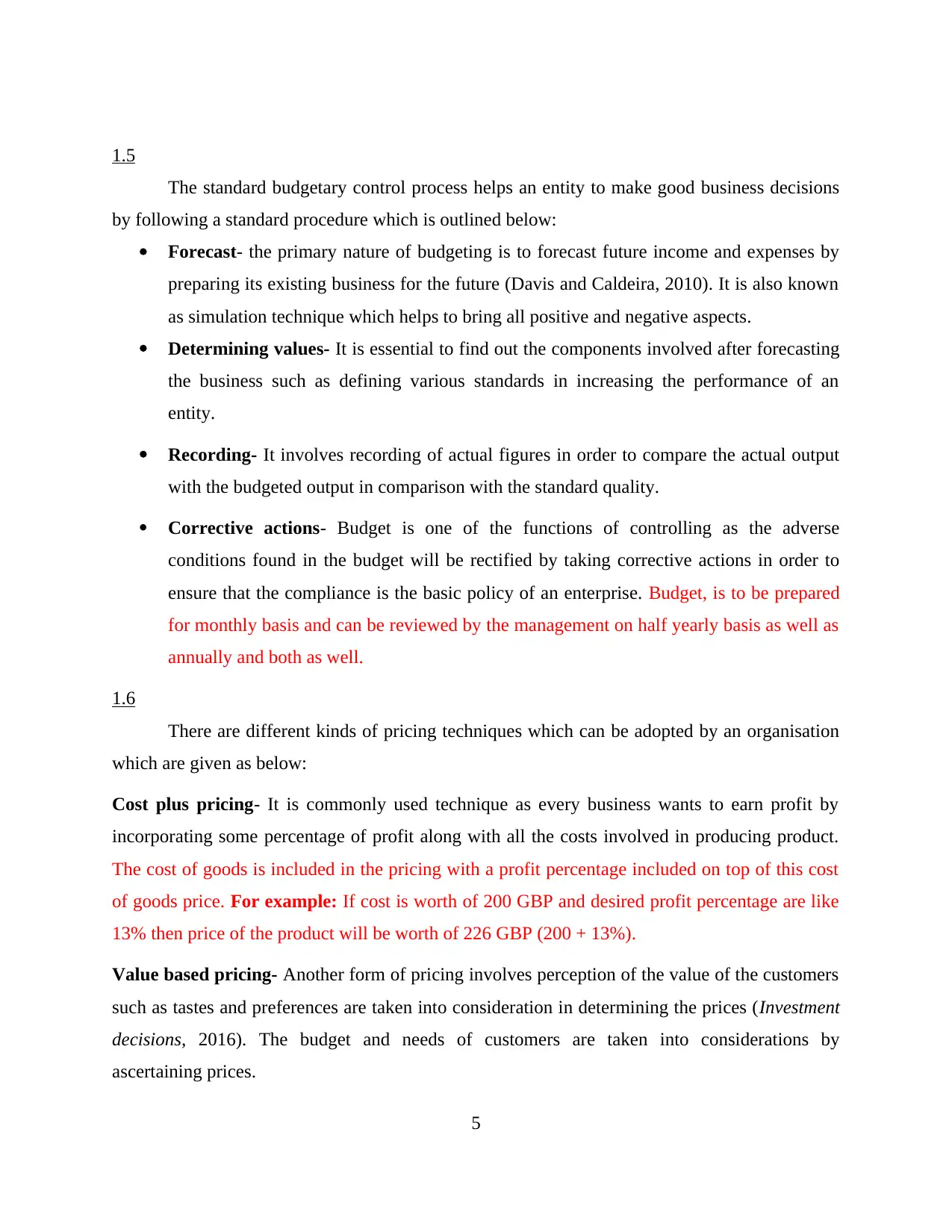
1.5
The standard budgetary control process helps an entity to make good business decisions
by following a standard procedure which is outlined below:
Forecast- the primary nature of budgeting is to forecast future income and expenses by
preparing its existing business for the future (Davis and Caldeira, 2010). It is also known
as simulation technique which helps to bring all positive and negative aspects.
Determining values- It is essential to find out the components involved after forecasting
the business such as defining various standards in increasing the performance of an
entity.
Recording- It involves recording of actual figures in order to compare the actual output
with the budgeted output in comparison with the standard quality.
Corrective actions- Budget is one of the functions of controlling as the adverse
conditions found in the budget will be rectified by taking corrective actions in order to
ensure that the compliance is the basic policy of an enterprise. Budget, is to be prepared
for monthly basis and can be reviewed by the management on half yearly basis as well as
annually and both as well.
1.6
There are different kinds of pricing techniques which can be adopted by an organisation
which are given as below:
Cost plus pricing- It is commonly used technique as every business wants to earn profit by
incorporating some percentage of profit along with all the costs involved in producing product.
The cost of goods is included in the pricing with a profit percentage included on top of this cost
of goods price. For example: If cost is worth of 200 GBP and desired profit percentage are like
13% then price of the product will be worth of 226 GBP (200 + 13%).
Value based pricing- Another form of pricing involves perception of the value of the customers
such as tastes and preferences are taken into consideration in determining the prices (Investment
decisions, 2016). The budget and needs of customers are taken into considerations by
ascertaining prices.
5
The standard budgetary control process helps an entity to make good business decisions
by following a standard procedure which is outlined below:
Forecast- the primary nature of budgeting is to forecast future income and expenses by
preparing its existing business for the future (Davis and Caldeira, 2010). It is also known
as simulation technique which helps to bring all positive and negative aspects.
Determining values- It is essential to find out the components involved after forecasting
the business such as defining various standards in increasing the performance of an
entity.
Recording- It involves recording of actual figures in order to compare the actual output
with the budgeted output in comparison with the standard quality.
Corrective actions- Budget is one of the functions of controlling as the adverse
conditions found in the budget will be rectified by taking corrective actions in order to
ensure that the compliance is the basic policy of an enterprise. Budget, is to be prepared
for monthly basis and can be reviewed by the management on half yearly basis as well as
annually and both as well.
1.6
There are different kinds of pricing techniques which can be adopted by an organisation
which are given as below:
Cost plus pricing- It is commonly used technique as every business wants to earn profit by
incorporating some percentage of profit along with all the costs involved in producing product.
The cost of goods is included in the pricing with a profit percentage included on top of this cost
of goods price. For example: If cost is worth of 200 GBP and desired profit percentage are like
13% then price of the product will be worth of 226 GBP (200 + 13%).
Value based pricing- Another form of pricing involves perception of the value of the customers
such as tastes and preferences are taken into consideration in determining the prices (Investment
decisions, 2016). The budget and needs of customers are taken into considerations by
ascertaining prices.
5
Paraphrase This Document
Need a fresh take? Get an instant paraphrase of this document with our AI Paraphraser

Market led pricing- Products or services offered by an entity will charge prices for its products
according to the latest trend in the market as their desired motive is to gain higher competitive
advantage in order to attract wide number of customers towards their products.
Skimming pricing method: In this kind of pricing strategy, at the initial level price of the
products and services are higher. As the time passes and product becomes old in the market then
charges or prices taken from the customer at the low rate ass compare to the initial time.
Market penetration pricing: Under this, at the initial time prices are relatively lower in
comparison to the over time. It is used by the companies for raising market share and totally
opposite to the skimming pricing method.
TASK 2
2.1
Table 1: Variance analysis and reconciliation statement
Particulars Actual Budget Outcome
Sales 69900 62000 -7900
Direct labour 24200 22512 -1688
Direct material 23260 19796 -3464
Fixed overheads 6000 6000 0
Operating profit 16440 13693 -2747.37
Table 2: Business performance
Particulars Actual Budget Results
Sales 69900 62000 Favourable
Direct labour 24200 22512 Adverse
Direct material 23260 19796 Adverse
6
according to the latest trend in the market as their desired motive is to gain higher competitive
advantage in order to attract wide number of customers towards their products.
Skimming pricing method: In this kind of pricing strategy, at the initial level price of the
products and services are higher. As the time passes and product becomes old in the market then
charges or prices taken from the customer at the low rate ass compare to the initial time.
Market penetration pricing: Under this, at the initial time prices are relatively lower in
comparison to the over time. It is used by the companies for raising market share and totally
opposite to the skimming pricing method.
TASK 2
2.1
Table 1: Variance analysis and reconciliation statement
Particulars Actual Budget Outcome
Sales 69900 62000 -7900
Direct labour 24200 22512 -1688
Direct material 23260 19796 -3464
Fixed overheads 6000 6000 0
Operating profit 16440 13693 -2747.37
Table 2: Business performance
Particulars Actual Budget Results
Sales 69900 62000 Favourable
Direct labour 24200 22512 Adverse
Direct material 23260 19796 Adverse
6
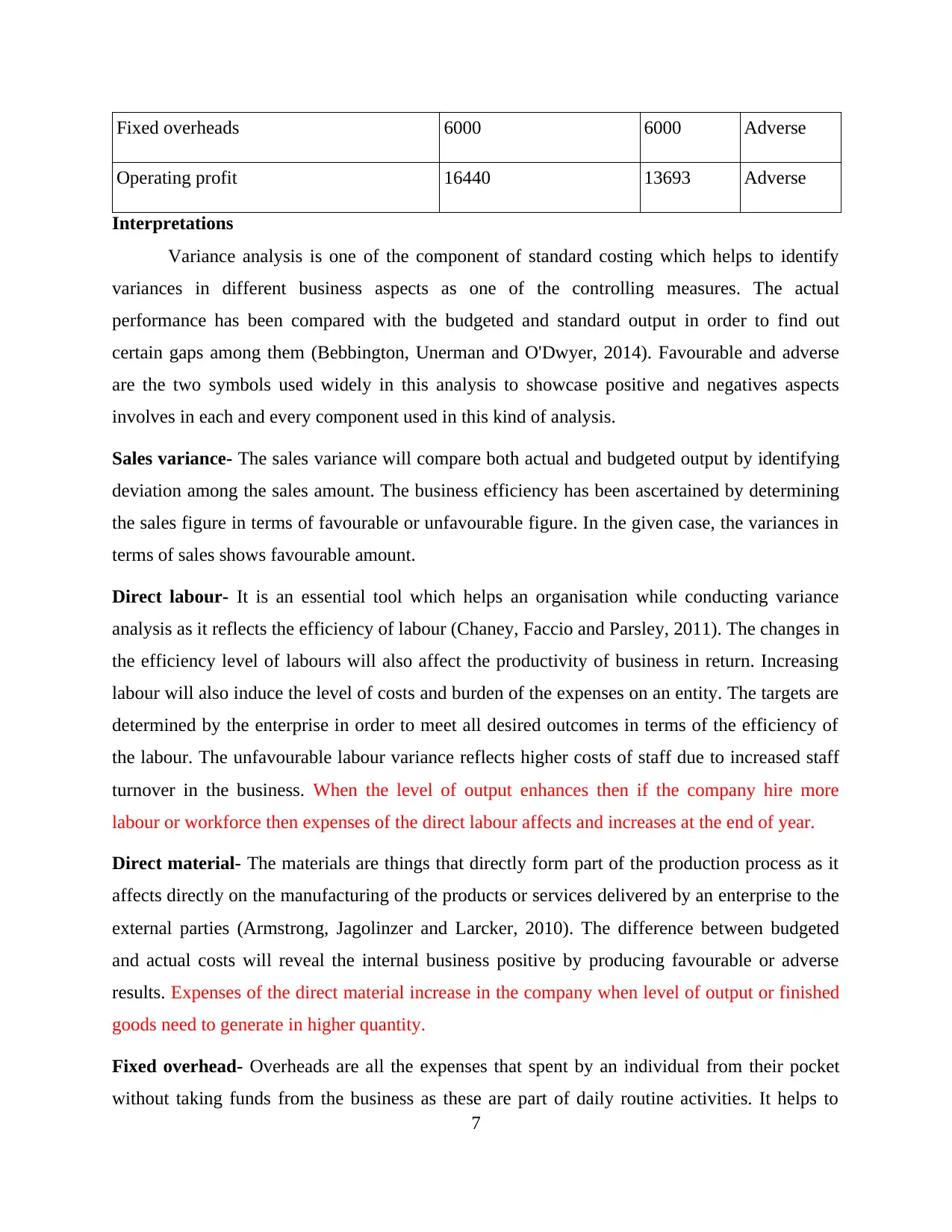
Fixed overheads 6000 6000 Adverse
Operating profit 16440 13693 Adverse
Interpretations
Variance analysis is one of the component of standard costing which helps to identify
variances in different business aspects as one of the controlling measures. The actual
performance has been compared with the budgeted and standard output in order to find out
certain gaps among them (Bebbington, Unerman and O'Dwyer, 2014). Favourable and adverse
are the two symbols used widely in this analysis to showcase positive and negatives aspects
involves in each and every component used in this kind of analysis.
Sales variance- The sales variance will compare both actual and budgeted output by identifying
deviation among the sales amount. The business efficiency has been ascertained by determining
the sales figure in terms of favourable or unfavourable figure. In the given case, the variances in
terms of sales shows favourable amount.
Direct labour- It is an essential tool which helps an organisation while conducting variance
analysis as it reflects the efficiency of labour (Chaney, Faccio and Parsley, 2011). The changes in
the efficiency level of labours will also affect the productivity of business in return. Increasing
labour will also induce the level of costs and burden of the expenses on an entity. The targets are
determined by the enterprise in order to meet all desired outcomes in terms of the efficiency of
the labour. The unfavourable labour variance reflects higher costs of staff due to increased staff
turnover in the business. When the level of output enhances then if the company hire more
labour or workforce then expenses of the direct labour affects and increases at the end of year.
Direct material- The materials are things that directly form part of the production process as it
affects directly on the manufacturing of the products or services delivered by an enterprise to the
external parties (Armstrong, Jagolinzer and Larcker, 2010). The difference between budgeted
and actual costs will reveal the internal business positive by producing favourable or adverse
results. Expenses of the direct material increase in the company when level of output or finished
goods need to generate in higher quantity.
Fixed overhead- Overheads are all the expenses that spent by an individual from their pocket
without taking funds from the business as these are part of daily routine activities. It helps to
7
Operating profit 16440 13693 Adverse
Interpretations
Variance analysis is one of the component of standard costing which helps to identify
variances in different business aspects as one of the controlling measures. The actual
performance has been compared with the budgeted and standard output in order to find out
certain gaps among them (Bebbington, Unerman and O'Dwyer, 2014). Favourable and adverse
are the two symbols used widely in this analysis to showcase positive and negatives aspects
involves in each and every component used in this kind of analysis.
Sales variance- The sales variance will compare both actual and budgeted output by identifying
deviation among the sales amount. The business efficiency has been ascertained by determining
the sales figure in terms of favourable or unfavourable figure. In the given case, the variances in
terms of sales shows favourable amount.
Direct labour- It is an essential tool which helps an organisation while conducting variance
analysis as it reflects the efficiency of labour (Chaney, Faccio and Parsley, 2011). The changes in
the efficiency level of labours will also affect the productivity of business in return. Increasing
labour will also induce the level of costs and burden of the expenses on an entity. The targets are
determined by the enterprise in order to meet all desired outcomes in terms of the efficiency of
the labour. The unfavourable labour variance reflects higher costs of staff due to increased staff
turnover in the business. When the level of output enhances then if the company hire more
labour or workforce then expenses of the direct labour affects and increases at the end of year.
Direct material- The materials are things that directly form part of the production process as it
affects directly on the manufacturing of the products or services delivered by an enterprise to the
external parties (Armstrong, Jagolinzer and Larcker, 2010). The difference between budgeted
and actual costs will reveal the internal business positive by producing favourable or adverse
results. Expenses of the direct material increase in the company when level of output or finished
goods need to generate in higher quantity.
Fixed overhead- Overheads are all the expenses that spent by an individual from their pocket
without taking funds from the business as these are part of daily routine activities. It helps to
7
⊘ This is a preview!⊘
Do you want full access?
Subscribe today to unlock all pages.

Trusted by 1+ million students worldwide
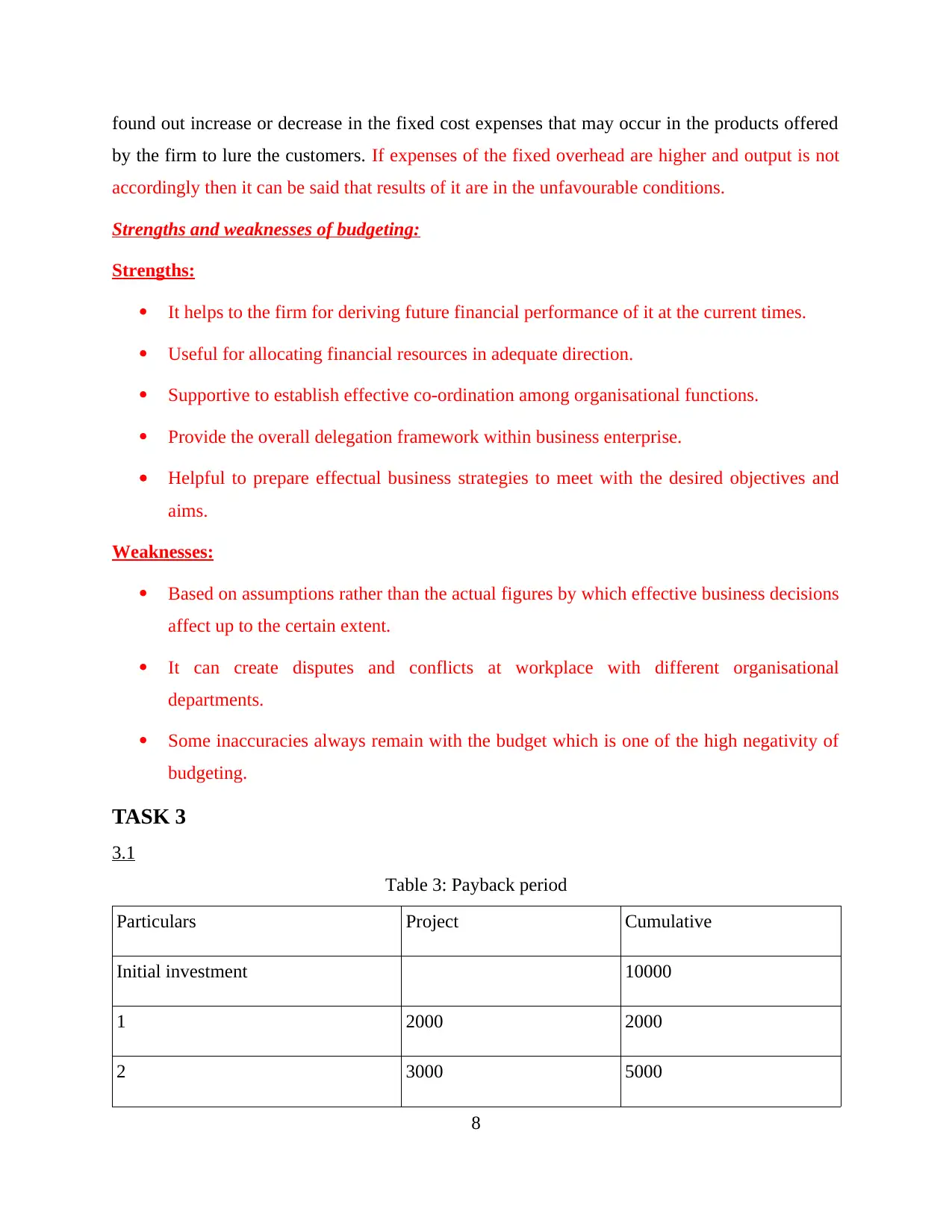
found out increase or decrease in the fixed cost expenses that may occur in the products offered
by the firm to lure the customers. If expenses of the fixed overhead are higher and output is not
accordingly then it can be said that results of it are in the unfavourable conditions.
Strengths and weaknesses of budgeting:
Strengths:
It helps to the firm for deriving future financial performance of it at the current times.
Useful for allocating financial resources in adequate direction.
Supportive to establish effective co-ordination among organisational functions.
Provide the overall delegation framework within business enterprise.
Helpful to prepare effectual business strategies to meet with the desired objectives and
aims.
Weaknesses:
Based on assumptions rather than the actual figures by which effective business decisions
affect up to the certain extent.
It can create disputes and conflicts at workplace with different organisational
departments.
Some inaccuracies always remain with the budget which is one of the high negativity of
budgeting.
TASK 3
3.1
Table 3: Payback period
Particulars Project Cumulative
Initial investment 10000
1 2000 2000
2 3000 5000
8
by the firm to lure the customers. If expenses of the fixed overhead are higher and output is not
accordingly then it can be said that results of it are in the unfavourable conditions.
Strengths and weaknesses of budgeting:
Strengths:
It helps to the firm for deriving future financial performance of it at the current times.
Useful for allocating financial resources in adequate direction.
Supportive to establish effective co-ordination among organisational functions.
Provide the overall delegation framework within business enterprise.
Helpful to prepare effectual business strategies to meet with the desired objectives and
aims.
Weaknesses:
Based on assumptions rather than the actual figures by which effective business decisions
affect up to the certain extent.
It can create disputes and conflicts at workplace with different organisational
departments.
Some inaccuracies always remain with the budget which is one of the high negativity of
budgeting.
TASK 3
3.1
Table 3: Payback period
Particulars Project Cumulative
Initial investment 10000
1 2000 2000
2 3000 5000
8
Paraphrase This Document
Need a fresh take? Get an instant paraphrase of this document with our AI Paraphraser
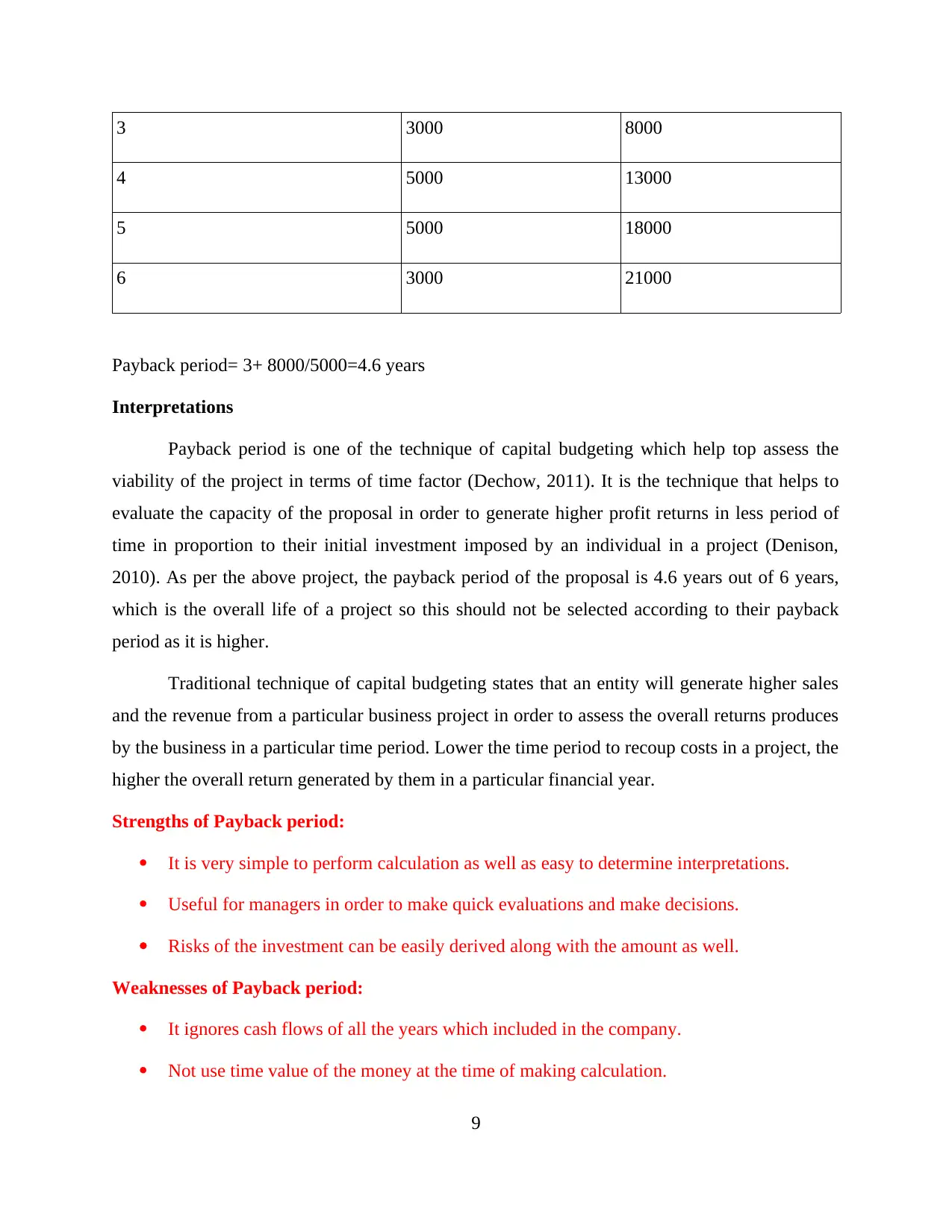
3 3000 8000
4 5000 13000
5 5000 18000
6 3000 21000
Payback period= 3+ 8000/5000=4.6 years
Interpretations
Payback period is one of the technique of capital budgeting which help top assess the
viability of the project in terms of time factor (Dechow, 2011). It is the technique that helps to
evaluate the capacity of the proposal in order to generate higher profit returns in less period of
time in proportion to their initial investment imposed by an individual in a project (Denison,
2010). As per the above project, the payback period of the proposal is 4.6 years out of 6 years,
which is the overall life of a project so this should not be selected according to their payback
period as it is higher.
Traditional technique of capital budgeting states that an entity will generate higher sales
and the revenue from a particular business project in order to assess the overall returns produces
by the business in a particular time period. Lower the time period to recoup costs in a project, the
higher the overall return generated by them in a particular financial year.
Strengths of Payback period:
It is very simple to perform calculation as well as easy to determine interpretations.
Useful for managers in order to make quick evaluations and make decisions.
Risks of the investment can be easily derived along with the amount as well.
Weaknesses of Payback period:
It ignores cash flows of all the years which included in the company.
Not use time value of the money at the time of making calculation.
9
4 5000 13000
5 5000 18000
6 3000 21000
Payback period= 3+ 8000/5000=4.6 years
Interpretations
Payback period is one of the technique of capital budgeting which help top assess the
viability of the project in terms of time factor (Dechow, 2011). It is the technique that helps to
evaluate the capacity of the proposal in order to generate higher profit returns in less period of
time in proportion to their initial investment imposed by an individual in a project (Denison,
2010). As per the above project, the payback period of the proposal is 4.6 years out of 6 years,
which is the overall life of a project so this should not be selected according to their payback
period as it is higher.
Traditional technique of capital budgeting states that an entity will generate higher sales
and the revenue from a particular business project in order to assess the overall returns produces
by the business in a particular time period. Lower the time period to recoup costs in a project, the
higher the overall return generated by them in a particular financial year.
Strengths of Payback period:
It is very simple to perform calculation as well as easy to determine interpretations.
Useful for managers in order to make quick evaluations and make decisions.
Risks of the investment can be easily derived along with the amount as well.
Weaknesses of Payback period:
It ignores cash flows of all the years which included in the company.
Not use time value of the money at the time of making calculation.
9
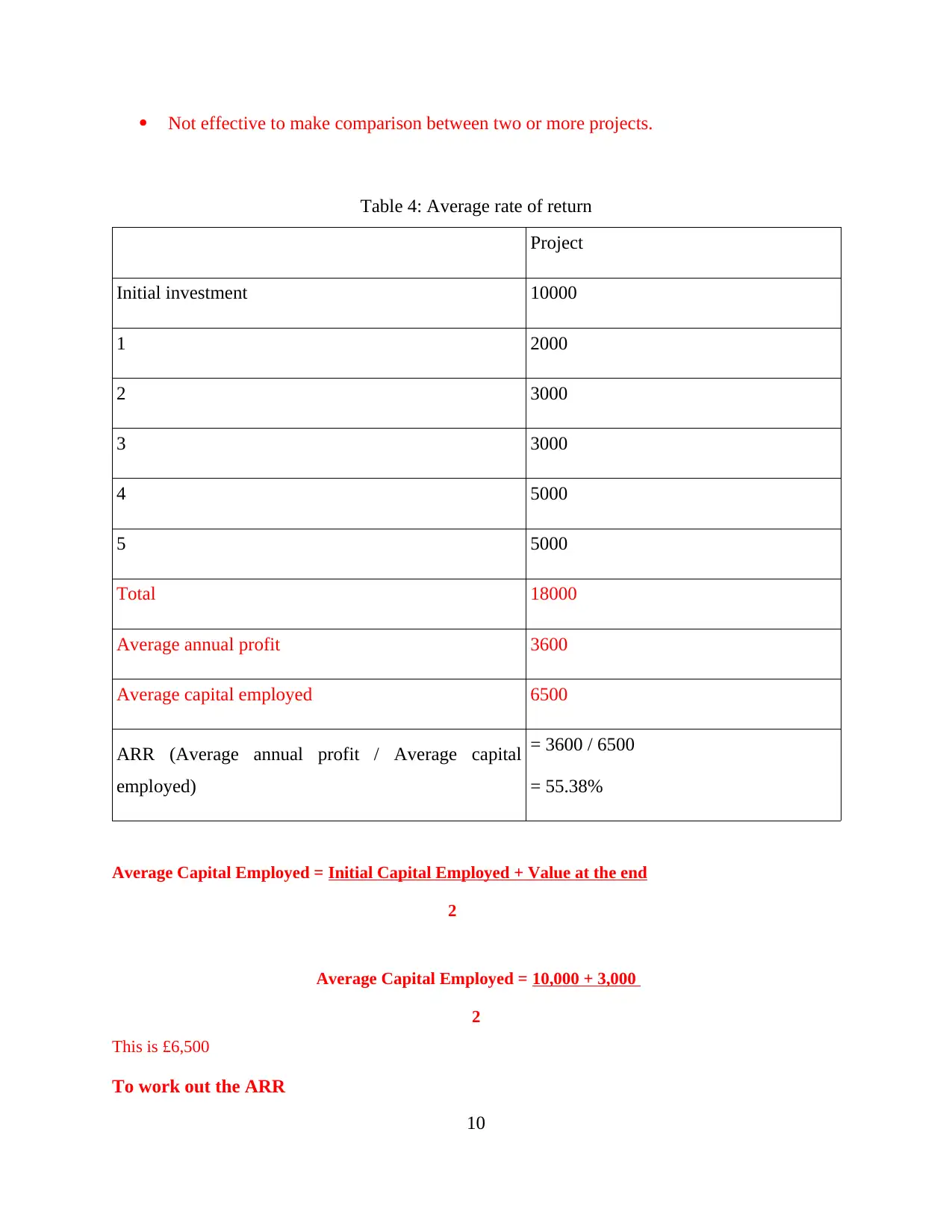
Not effective to make comparison between two or more projects.
Table 4: Average rate of return
Project
Initial investment 10000
1 2000
2 3000
3 3000
4 5000
5 5000
Total 18000
Average annual profit 3600
Average capital employed 6500
ARR (Average annual profit / Average capital
employed)
= 3600 / 6500
= 55.38%
Average Capital Employed = Initial Capital Employed + Value at the end
2
Average Capital Employed = 10,000 + 3,000
2
This is £6,500
To work out the ARR
10
Table 4: Average rate of return
Project
Initial investment 10000
1 2000
2 3000
3 3000
4 5000
5 5000
Total 18000
Average annual profit 3600
Average capital employed 6500
ARR (Average annual profit / Average capital
employed)
= 3600 / 6500
= 55.38%
Average Capital Employed = Initial Capital Employed + Value at the end
2
Average Capital Employed = 10,000 + 3,000
2
This is £6,500
To work out the ARR
10
⊘ This is a preview!⊘
Do you want full access?
Subscribe today to unlock all pages.

Trusted by 1+ million students worldwide
1 out of 18
Related Documents
Your All-in-One AI-Powered Toolkit for Academic Success.
+13062052269
info@desklib.com
Available 24*7 on WhatsApp / Email
![[object Object]](/_next/static/media/star-bottom.7253800d.svg)
Unlock your academic potential
Copyright © 2020–2025 A2Z Services. All Rights Reserved. Developed and managed by ZUCOL.





